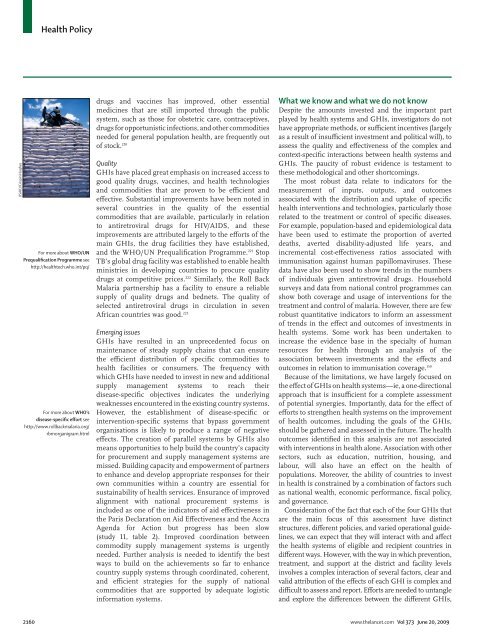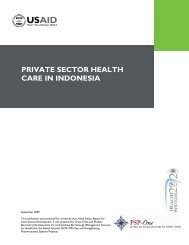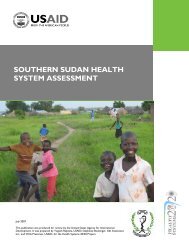An assessment of interactions between global ... - ResearchGate
An assessment of interactions between global ... - ResearchGate
An assessment of interactions between global ... - ResearchGate
Create successful ePaper yourself
Turn your PDF publications into a flip-book with our unique Google optimized e-Paper software.
Health Policy<br />
USAID/Crispin Hughes<br />
For more about WHO/UN<br />
Prequalification Programme see<br />
http://healthtech.who.int/pq/<br />
For more about WHO’s<br />
disease-specific effort see<br />
http://www.rollbackmalaria.org/<br />
rbmorganigram.html<br />
drugs and vaccines has improved, other essential<br />
medicines that are still imported through the public<br />
system, such as those for obstetric care, contraceptives,<br />
drugs for opportunistic infections, and other commodities<br />
needed for general population health, are frequently out<br />
<strong>of</strong> stock. 220<br />
Quality<br />
GHIs have placed great emphasis on increased access to<br />
good quality drugs, vaccines, and health technologies<br />
and commodities that are proven to be efficient and<br />
effective. Substantial improvements have been noted in<br />
several countries in the quality <strong>of</strong> the essential<br />
commodities that are available, particularly in relation<br />
to antiretroviral drugs for HIV/AIDS, and these<br />
improvements are attributed largely to the efforts <strong>of</strong> the<br />
main GHIs, the drug facilities they have established,<br />
and the WHO/UN Prequalification Programme. 221 Stop<br />
TB’s <strong>global</strong> drug facility was established to enable health<br />
ministries in developing countries to procure quality<br />
drugs at competitive prices. 222 Similarly, the Roll Back<br />
Malaria partnership has a facility to ensure a reliable<br />
supply <strong>of</strong> quality drugs and bednets. The quality <strong>of</strong><br />
selected antiretroviral drugs in circulation in seven<br />
African countries was good. 223<br />
Emerging issues<br />
GHIs have resulted in an unprecedented focus on<br />
maintenance <strong>of</strong> steady supply chains that can ensure<br />
the efficient distribution <strong>of</strong> specific commodities to<br />
health facilities or consumers. The frequency with<br />
which GHIs have needed to invest in new and additional<br />
supply management systems to reach their<br />
disease-specific objectives indicates the underlying<br />
weaknesses encountered in the existing country systems.<br />
However, the establishment <strong>of</strong> disease-specific or<br />
intervention- specific systems that bypass government<br />
organisations is likely to produce a range <strong>of</strong> negative<br />
effects. The creation <strong>of</strong> parallel systems by GHIs also<br />
means opportunities to help build the country’s capacity<br />
for procurement and supply management systems are<br />
missed. Building capacity and empowerment <strong>of</strong> partners<br />
to enhance and develop appropriate responses for their<br />
own communities within a country are essential for<br />
sustainability <strong>of</strong> health services. Ensurance <strong>of</strong> improved<br />
alignment with national procurement systems is<br />
included as one <strong>of</strong> the indicators <strong>of</strong> aid effectiveness in<br />
the Paris Declaration on Aid Effectiveness and the Accra<br />
Agenda for Action but progress has been slow<br />
(study 11, table 2). Improved coordination <strong>between</strong><br />
commodity supply management systems is urgently<br />
needed. Further analysis is needed to identify the best<br />
ways to build on the achievements so far to enhance<br />
country supply systems through coordinated, coherent,<br />
and efficient strategies for the supply <strong>of</strong> national<br />
commodities that are supported by adequate logistic<br />
information systems.<br />
What we know and what we do not know<br />
Despite the amounts invested and the important part<br />
played by health systems and GHIs, investigators do not<br />
have appropriate methods, or sufficient incentives (largely<br />
as a result <strong>of</strong> insufficient investment and political will), to<br />
assess the quality and effectiveness <strong>of</strong> the complex and<br />
context-specific <strong>interactions</strong> <strong>between</strong> health systems and<br />
GHIs. The paucity <strong>of</strong> robust evidence is testament to<br />
these methodological and other shortcomings.<br />
The most robust data relate to indicators for the<br />
measurement <strong>of</strong> inputs, outputs, and outcomes<br />
associated with the distribution and uptake <strong>of</strong> specific<br />
health interventions and technologies, particularly those<br />
related to the treatment or control <strong>of</strong> specific diseases.<br />
For example, population-based and epidemiological data<br />
have been used to estimate the proportion <strong>of</strong> averted<br />
deaths, averted disability-adjusted life years, and<br />
incremental cost-effectiveness ratios associated with<br />
immunisation against human papillomaviruses. These<br />
data have also been used to show trends in the numbers<br />
<strong>of</strong> individuals given antiretroviral drugs. Household<br />
surveys and data from national control programmes can<br />
show both coverage and usage <strong>of</strong> interventions for the<br />
treatment and control <strong>of</strong> malaria. However, there are few<br />
robust quantitative indicators to inform an <strong>assessment</strong><br />
<strong>of</strong> trends in the effect and outcomes <strong>of</strong> investments in<br />
health systems. Some work has been undertaken to<br />
increase the evidence base in the specialty <strong>of</strong> human<br />
resources for health through an analysis <strong>of</strong> the<br />
association <strong>between</strong> investments and the effects and<br />
outcomes in relation to immunisation coverage. 150<br />
Because <strong>of</strong> the limitations, we have largely focused on<br />
the effect <strong>of</strong> GHIs on health systems—ie, a one-directional<br />
approach that is insufficient for a complete <strong>assessment</strong><br />
<strong>of</strong> potential synergies. Importantly, data for the effect <strong>of</strong><br />
efforts to strengthen health systems on the improvement<br />
<strong>of</strong> health outcomes, including the goals <strong>of</strong> the GHIs,<br />
should be gathered and assessed in the future. The health<br />
outcomes identified in this analysis are not associated<br />
with interventions in health alone. Association with other<br />
sectors, such as education, nutrition, housing, and<br />
labour, will also have an effect on the health <strong>of</strong><br />
populations. Moreover, the ability <strong>of</strong> countries to invest<br />
in health is constrained by a combination <strong>of</strong> factors such<br />
as national wealth, economic performance, fiscal policy,<br />
and governance.<br />
Consideration <strong>of</strong> the fact that each <strong>of</strong> the four GHIs that<br />
are the main focus <strong>of</strong> this <strong>assessment</strong> have distinct<br />
structures, different policies, and varied operational guidelines,<br />
we can expect that they will interact with and affect<br />
the health systems <strong>of</strong> eligible and recipient countries in<br />
different ways. However, with the way in which prevention,<br />
treatment, and support at the district and facility levels<br />
involves a complex interaction <strong>of</strong> several factors, clear and<br />
valid attribution <strong>of</strong> the effects <strong>of</strong> each GHI is complex and<br />
difficult to assess and report. Efforts are needed to untangle<br />
and explore the differences <strong>between</strong> the different GHIs,<br />
2160 www.thelancet.com Vol 373 June 20, 2009
















